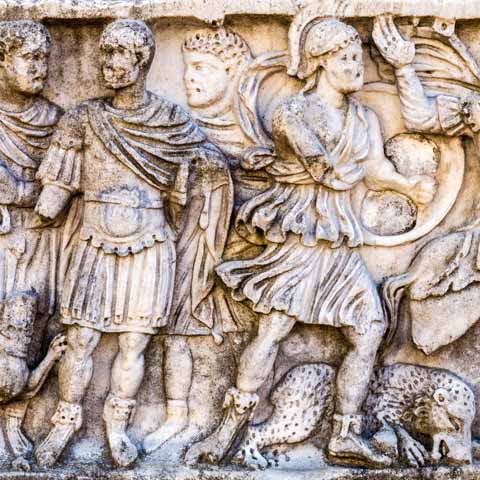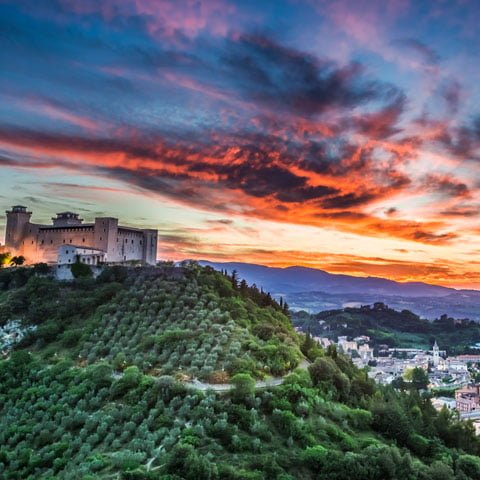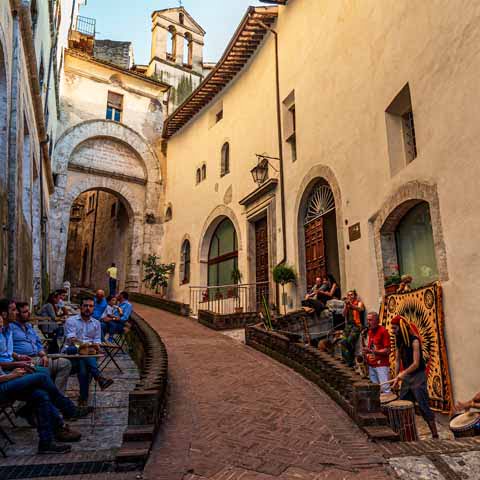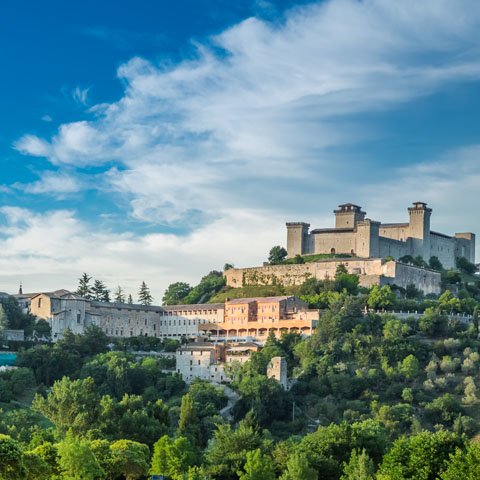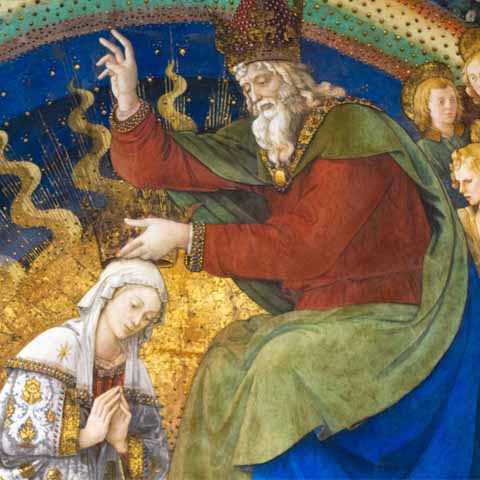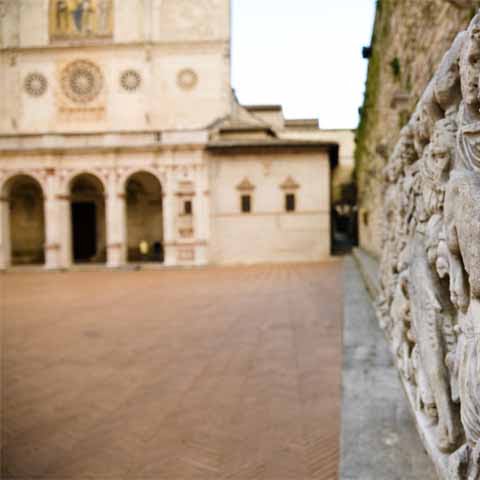Positioned at the feet of Monteluco in a large valley, Spoleto is one of the oldest cities in Umbria and has been inhabited since prehistoric times. According to historians, the city was strategically positioned for the Umbrian people. Celebrated by the greatest writers over the centuries, Spoleto was once the capital of the powerful Duchy of Spoleto.
Spoleto’s center features Roman ruins and Romanesque churches with Paleo Christian origins, however the city’s most iconic monument is the arched Ponte delle Torri bridge, that is surrounded by a sea of greenery. Today, the town of Spoleto attracts international travelers thanks to its tranquil atmosphere and rich culture.
PREHISTORY OF SPOLETO
The construction of the defensive city walls can be traced back to the 5th century BC.
In 241 BC, Spoleto became a Roman colony known as Spoletium.
In 217 BC, during the Second Punic War, Hannibal and the Carthaginians defeated the Roman Army in the Battle of Trasimeno. Once in Spoleto, legend narrates that Hannibal’s army suffered numerous losses as a result of the strong-willed inhabitants of Spoleto. It is said that boiling oil was thrown on enemy soldiers from what is now called The Oil Tower (Torre dell’Olio). An inscription on the Porta Romana commemorates this precise event.
Subsequently, the civil wars of Gaius Marius and Sulla weakened Spoleto. Sulla won over Marius and in 82 BC confiscated the territory of Spoletium with the city being granted the concession of “municipium.”
Evidence of the flourishing Roman municipium is still visible to visitors today, with the Roman Theater, the Arch of Drusus and Germanicus, and the Roman House, attributed to the mother of Emperor Vespasian, all still surviving in some form.
HISTORY OF SPOLETO
During the fourth century Spoleto became an Episcopal See and developed a sound ecclesiastic organization. Owing to its elevated position, Spoleto was an important stronghold during the Vandal and Gothic wars.
The Lombards, a Germanic people, invaded Italy in 568 AD and conquered much of it, establishing the Kingdom of the Lombards, which was divided among several dukes dependent on the King. The Lombard Duchy of Spoleto remained largely independent until 729 AD, when it was subjugated to the Longobard King Liutprand. Starting in 571 AD, the Longobards in Italy dramatically enhanced the city’s political status. Faroald I was the name of the first Duke of Spoleto.
Ariulfo, the second Duke of Spoleto, threatened Rome in 591. The duchy was territorially consolidated in the mountainous part of Central Italy.
There is no significant news of the subsequent Duke Teodelapio, nor his successor, Attone.
With the death of Attone, King Grimoaldo himself appointed the new Duke of Spoleto, Transamondo count of Capua, however, after the death of Grimoaldo (671) the duchy actually resumed its autonomy. Faroaldo II subsequently renounced the ducal dignity. From that moment, the duchy was closely linked to the Lombard kingdom.
The Lombard Kingdom fell under the control of the Frankish and German imperial dynasties in 774 A.D. Spoleto became part of the Holy Roman Empire at that time.
The army of Emperor Frederick Barbarossa occupied Italy in order to end the growing local autonomies that were weakening the power of the Empire. While in the Po Valley, Barbarossa was defeated by the Lombard League and had to accept the autonomy of many cities. Still, Barbarossa managed to destroy the walls of Spoleto in 1155 and enter the city, setting it on fire.
Afterwards, Barbarossa appointed his General Guarnieri as the Duke of Spoleto. He was succeeded by Guelfo VI, who, in addition to being Duke of Spoleto, was awarded the title of Marquis of Tuscany. Guelfo VI belonged to a noble family that was a rival of the Swabian family.
Spoleto lost its autonomy, yet it was a prosperous period for the duchy as the Emperor, in order to affirm his greatness, made many investments and transformed the duchy into an important commercial center.
Subsequently, the Duchy of Spoleto was assigned to characters very close to the Swabian family.
During the tenth century, no duke managed to keep power for long, while during the eleventh and twelfth centuries the duchy was conferred several times by the emperors to their great German vassals. The last actual Duke of Spoleto was Conrad of Urslingen, forced by Pope Innocent III to hand over his power to Cardinal Gregorio Crescenzi (1198) and the city was annexed to the Papal States.
In 1230, Spoleto was definitively occupied by the Papacy, thanks to the Treaty of San Germano, stipulated by the Emperor Frederick II of Swabia and by Pope Gregory IX. Gregory IX inaugurated the series of popes who resided there.
During the fourteenth century, the Duchy of Spoleto was also the scene of the struggles between the Guelphs (supporters of the Pope) and Ghibellines (supporters of the Holy Roman Empire).
In 1324, Perugia intervened in favor of the Guelphs, imposing a mayor on Spoleto and building its own fortress.
In 1362, Cardinal Albornoz chose Spoleto as stronghold of the Papal States and commissioned architect Gattapone to build the Rocca, which became the domicile of the duchy’s rectors at the end of the fourteenth century.
The city rebelled against papal rule in 1474, but the movement was quelled by Cardinal Giuliano della Rovere.
Following these events, Spoleto’s history followed that of the Papal States.
Between 1809 and 1815, during the Napoleonic Empire, Spoleto was the capital of the French Trasimene Department for five years. Following Napoleon’s defeat, Spoleto returned to the Pope.
In 1860, Spoleto was occupied by the Piedmontese troops fighting for the Unification of Italy.
During the period between Italian Unification and the two World Wars, Spoleto experienced a period of economic and demographic crisis. Immediately following the end of World War II, Spoleto was affected by massive emigration, that saw many locals move north for jobs. However, the city made an effort to keep itself alive thanks to cultural initiatives promoted by various bodies and the municipal administration.
In 1947, the Experimental Lyric Theater was founded, while in 1952 the Italian Center for Studies on the Early Middle Ages was inaugurated, and in 1958 the first edition of the Festival dei Due Mondi took place.
Activities related to the tourism-cultural sector have assumed a primary role in the local economy and continue to be the main resource for the city.
ARCHAEOLOGY OF SPOLETO
The testimonies of man in the territory of Spoleto in the most remote periods are limited to some lithic discoveries and to a burial found consisting of five flint arrowheads placed in a tomb, an action meant to underline the societal role of the deceased.
Several necropolises have been discovered since the nineteenth century in the countryside in the surroundings of the city.
Two princely burials stand out with extraordinarily rich funerary artifacts including some scepters made with a refined technique that combines iron and bronze as well as anthropomorphic and zoomorphic representations that underline the power of the local ruler.
The National Archaeological Museum of Spoleto was founded in 1985 within the former Monastery of Sant’Agata. The exhibition itinerary offers evidence of human presence in the city and its territory from the Neolithic Period and Bronze Age as well as the development of the settlement in the Umbrian phase. The museum also traces the history of the city in the subsequent phases of Romanization with inscriptions dedicated to the deities and architectural terracotta from the sanctuaries.
The city is also home to a Roman Theater that dates back to the first century BC. Today, the theater preserves an auditorium that measures approximately 230 feet in diameter. Starting from the sixth century AD, the building was gradually buried and the Church of Sant’Agata was built there. The structure was eventually re-discovered following a landslide in the twentieth century.
The Necropolis of Piazza d’Armi represents one of the most important archaeological finds of recent years in Umbria. The discovery of the necropolis dates back to 1982, when the first tomb containing a rare example of an Etruscan bronze tripod came to light. Later, during the excavation campaigns, other burials were discovered including two large portions of the necropolis located at the base of the slope of Colle San Tommaso. Here it is possible to admire a remarkable collection of funerary artifacts including pottery, weapons, bronze tools, silver ornaments, jewelry, scepters, and more.
The Arch of Drusus and Germanicus was the triumphal access to the Roman area. The monument was constructed in 23 AD to honor Drusus and Germanicus, Emperor Tiberius’ son and adoptive son.
During the excavation of the Roman House, an inscription dedicated to Emperor Caligula from Polla was discovered. For this reason, the house may have been owned by Vespasia Polla, the mother of Emperor Vespasian. Dating back to the first century AD, visitors to the house can admire beautiful floor mosaics as well the typical layout of patrician houses between the end of the Republican period and the beginning of the Empire.
Don't just see Italy, live it.
Your dream trip to Italy has never been closer
No more endlessly scrolling travel sites. Our travel experts will craft the perfect, one-of-a-kind trip just for you.

300+
DESTINATIONS
We offer more Italian destinations than any travel site. Do and see more with Trips 2 Italy.
1 (of a kind)
ITINERARIES
Because your dream trip to Italy should be designed for you, not for the masses.
100%
PEACE OF MIND
From flights and accommodations, to food and activities - we take care of every detail.
